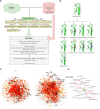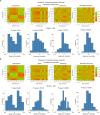Large-scale template-based structural modeling of T-cell receptors with known antigen specificity reveals complementarity features
- PMID: 37649481
- PMCID: PMC10464843
- DOI: 10.3389/fimmu.2023.1224969
Large-scale template-based structural modeling of T-cell receptors with known antigen specificity reveals complementarity features
Abstract
Introduction: T-cell receptor (TCR) recognition of foreign peptides presented by the major histocompatibility complex (MHC) initiates the adaptive immune response against pathogens. While a large number of TCR sequences specific to different antigenic peptides are known to date, the structural data describing the conformation and contacting residues for TCR-peptide-MHC complexes is relatively limited. In the present study we aim to extend and analyze the set of available structures by performing highly accurate template-based modeling of these complexes using TCR sequences with known specificity.
Methods: Identification of CDR3 sequences and their further clustering, based on available spatial structures, V- and J-genes of corresponding T-cell receptors, and epitopes, was performed using the VDJdb database. Modeling of the selected CDR3 loops was conducted using a stepwise introduction of single amino acid substitutions to the template PDB structures, followed by optimization of the TCR-peptide-MHC contacting interface using the Rosetta package applications. Statistical analysis and recursive feature elimination procedures were carried out on computed energy values and properties of contacting amino acid residues between CDR3 loops and peptides, using R.
Results: Using the set of 29 complex templates (including a template with SARS-CoV-2 antigen) and 732 specificity records, we built a database of 1585 model structures carrying substitutions in either TCRα or TCRβ chains with some models representing the result of different mutation pathways for the same final structure. This database allowed us to analyze features of amino acid contacts in TCR - peptide interfaces that govern antigen recognition preferences and interpret these interactions in terms of physicochemical properties of interacting residues.
Conclusion: Our results provide a methodology for creating high-quality TCR-peptide-MHC models for antigens of interest that can be utilized to predict TCR specificity.
Keywords: T-cell receptor; TCR-peptide-MHC complex; antigen recognition; database; structural modeling.
Copyright © 2023 Shcherbinin, Karnaukhov, Zvyagin, Chudakov and Shugay.
Conflict of interest statement
The authors declare that the research was conducted in the absence of any commercial or financial relationships that could be construed as a potential conflict of interest.
Figures





Similar articles
-
The presumptive CDR3 regions of both T cell receptor alpha and beta chains determine T cell specificity for myoglobin peptides.J Exp Med. 1990 Jul 1;172(1):27-33. doi: 10.1084/jem.172.1.27. J Exp Med. 1990. PMID: 1694219 Free PMC article.
-
TcR recognition of the MHC-peptide dimer: structural properties of a ternary complex.J Mol Biol. 1996 Aug 9;261(1):72-89. doi: 10.1006/jmbi.1996.0442. J Mol Biol. 1996. PMID: 8760503
-
Structural analysis of two HLA-DR-presented autoantigenic epitopes: crucial role of peripheral but not central peptide residues for T-cell receptor recognition.Mol Immunol. 2000 Oct;37(14):813-25. doi: 10.1016/s0161-5890(00)00109-7. Mol Immunol. 2000. PMID: 11257303
-
The structural interactions between T cell receptors and MHC-peptide complexes place physical limits on self-nonself discrimination.Curr Top Microbiol Immunol. 2005;296:19-37. doi: 10.1007/3-540-30791-5_2. Curr Top Microbiol Immunol. 2005. PMID: 16329190 Review.
-
Structural and dynamic control of T-cell receptor specificity, cross-reactivity, and binding mechanism.Immunol Rev. 2012 Nov;250(1):10-31. doi: 10.1111/j.1600-065X.2012.01165.x. Immunol Rev. 2012. PMID: 23046120 Review.
Cited by
-
TULIP: A transformer-based unsupervised language model for interacting peptides and T cell receptors that generalizes to unseen epitopes.Proc Natl Acad Sci U S A. 2024 Jun 11;121(24):e2316401121. doi: 10.1073/pnas.2316401121. Epub 2024 Jun 5. Proc Natl Acad Sci U S A. 2024. PMID: 38838016 Free PMC article.
References
-
- Demonstrated Protocol, CG000203 (2022). Available at: https://www.10xgenomics.com/support/single-cell-immune-profiling/documen....
Publication types
MeSH terms
Substances
LinkOut - more resources
Full Text Sources
Medical
Research Materials
Miscellaneous

